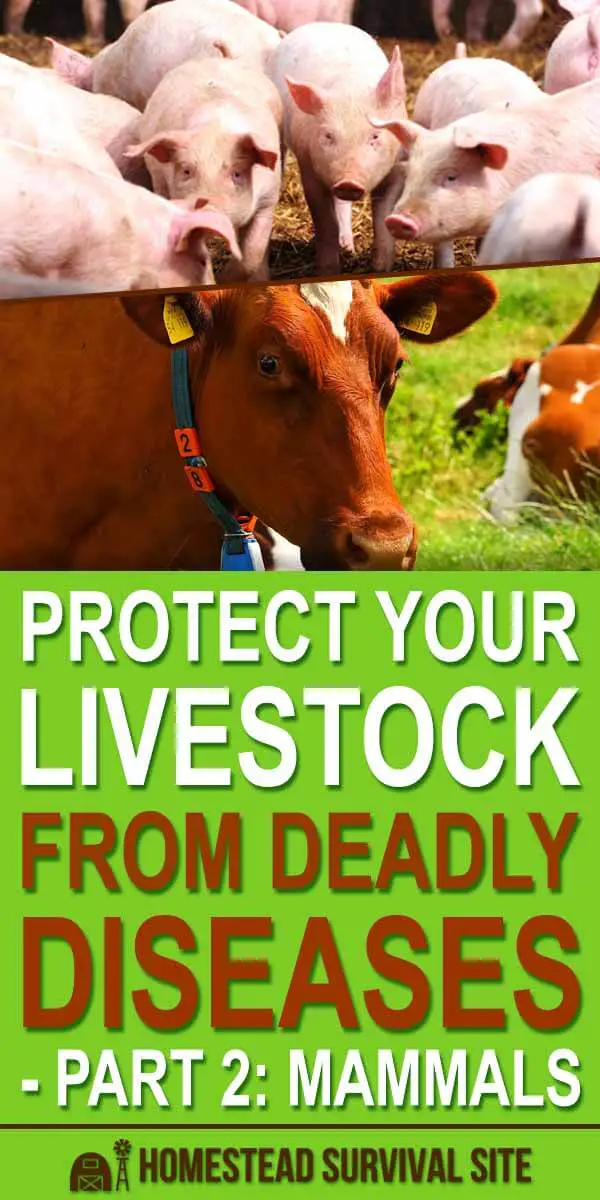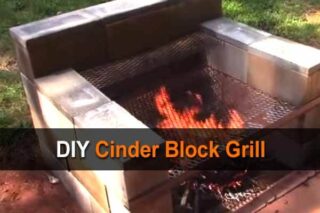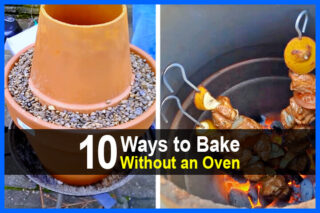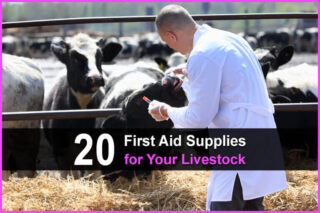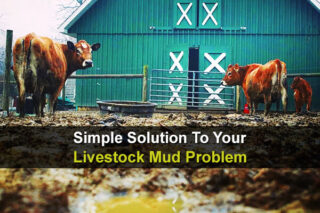Estimated reading time: 9 minutes
This week we continue our two-part series on protecting livestock from deadly diseases. (Click here to read part one.)
Keeping livestock healthy in order to provide meat and dairy for the family table is a top priority for all homesteaders. There won't always be time to wait for a veterinarian to arrive and treat an injury or deadly illness. Besides, you may not have the extra funds to pay for an expensive home visit and commercial medicine – or you might not want unnatural ingredients pumped into your meat and dairy producers.
As noted in part one of this livestock disease prevention series, learning how to tend to the livestock being raised on your land is the best way (and the only way during a disaster) to keep the animals in good health.
Deworming
All animals can contract a multitude of different types of worms and parasites. Stocking up on commercially manufactured worming products is just one way to ensure the animals don't become infected and/or their meat spoiled by worms.
The most reliable and economical natural dewormer I have ever come across is diatomaceous earth. The food grade version of diatomaceous earth (which is also used by humans to flush toxins from the body) is typically sold in 25 to 50-pound bags at agricultural stores (although you can get smaller bags online).
Diatomaceous earth (DE) is an extremely fine powder made from fossilized aquatic matter. You can sprinkle up to 1 tablespoon of DE onto feed in livestock feeders, or stir a whole bag into your feed tub with livestock feed to use as a preventative. When a worm or other parasite infestation has been detected, making a DE-based herb ball as a medicinal treatment is recommended.
When using DE as a preventative, feed it to the livestock every day for at least 15 days to ensure all the worms have been killed and expelled from the animal’s body.
Herbal Diatomaceous Earth Ball Dewormer Recipe
If using herbal balls to prevent worms, give one ball every 6 to 8 weeks. If you're treating an active worm infestation, give one ball every week. Wormwood, one of the ingredients in the herbal ball recipe, should be restricted to once or twice a month. Long-term consumption of wormwood may be harmful to both livestock and people.
Dosage
- Give 2 teaspoons per pound of body weight when treating domestic pets and medium livestock.
- When giving herbal balls to small livestock like rabbits and poultry birds, cut this dosage in half. Small livestock typically consume the herbal balls easier–especially if suffering from throat worms–when it is crumbled and sprinkled onto their feed.
- Give 1 tablespoon of herbal balls to large livestock per 100 pounds of body weight.
- Never give herbal balls to animals younger than three weeks of age.
Ingredients
- 2 cups of DE
- 1 cup of ginger root
- 1 cup of rosemary
- 1 cup of anise powder or all spice
- 1 cup of powdered or minced garlic
- 1 cup of powdered black walnut hulls – except when the balls are to be given to nursing or pregnant animals or equines.
- 1 cup of cayenne pepper
- ½ of powdered cloves – whole cloves can be used if the herbal balls are to be given to large livestock.
- 1 cup of cinnamon
- 2 cups of wormwood – unless the herbal balls are being given to nursing or pregnant livestock or humans
- 1 cp of psyllium – optional
- 1 cup of powdered mustard seed
- 2 cups of sage
- 2 cups of thyme
Directions
- Mix all of the ingredients together thoroughly.
- Form the mixture into little balls (no more than a tablespoon) and feed them to livestock.
Drenching
When livestock become bloated, drenching is often required to relieve the pressure on internal organs before it becomes deadly. When drenching sessions do not work, poking the bloated area with a sharp and sterile needle in just the right spot may relieve gas pressure, but if the poke is done too deeply or even a fingernail width away from the right spot, the result will likely be deadly.
Poking a bloated animal with a needle should only be done as a last resort and only by an individual who has been instructed about the proper location by a vet or seasoned animal caregiver.
Ruminant animals, like goats and cows, are more prone to bloat than most other forms of livestock. Ruminant animals have four chambers in their stomach. When the animals eat too much of the right or wrong thing, their ruminant stops working properly.
The first indication of oncoming bloat comes when a ruminant stops chewing its cud. If you notice the look of swelling solely on the left side when facing the animal, it could be bloat.
Instead of buying commercial bloat drenching liquid, you can make a natural and, in my experience, superior medication to flush out the bloat. A rubber tube or livestock bottle is inserted into the mouth to pour the liquid down the animal’s throat, being careful not to pour the fluid into the lungs instead of the stomach, which would be a deadly mistake.
The drenching process helps break apart the large and dense pockets of gas in the animal’s stomach. When working with bloated goats, stand them up on their hind legs to help put gentle pressure on the gas while drenching.
Rub the side and not the bottom of the stomach consistently and gently to help move the gas pockets around during and after drenching. When the animal begins to pass gas and/or burp, you know the drenching process is working. It may take several drenching sessions to completely relieve the bloat.
Sprinkling baking soda onto livestock feed on a regular basis may also help prevent bloat from occurring. Leaving out a bowl of baking soda as a free choice snack is also highly recommended.
DIY Natural Drenching Mixture
Ingredients
- 1 tablespoon of peppermint oil
- ½ to ¾ of a cup of carrier oil – mineral oil and almond oil are highly recommended, but common cooking oil works also.
- 2 tablespoons baking soda
Directions
Mix all of the ingredients together and pour through a drenching tube or into a livestock bottle and gently force the bloated animal to drink it.
Scours
Scours is what diarrhea in livestock is called. Scours could be indicative of a serious or contagious illness. If scours is left untreated, even if it is not linked to another health condition, it can become fatal if the animal becomes dehydrated.
Regularly review both the droppings and rear ends of livestock for signs of scours and dried runny scours stains on the animal. Catching the condition early will increase the animal's chances of survival, especially if scours is but one symptom of a larger problem.
Warning: It is possible for people to be stricken with diarrhea and serious stomach cramps if they come into contact with infected livestock scours.
Natural Electrolyte Scours Treatment
Ingredients
- 8 tablespoons of molasses or honey – or a combination of the two
- 1 and ½ teaspoons of baking soda
- 2 teaspoons of salt – sea salt works best
- 4 quarts of water – lukewarm
Directions
Mix all of the electrolyte scours treatment ingredients together and pour into an empty waterer or force feed gently with a livestock bottle or drenching tube.
The dosage noted in the recipe is for medium or large livestock. Cut the amount in half (at least) for small livestock as well as Nigerian dwarf or pygmy goats. It may take several days of giving the treatment once a day to stop the scours.
“Miracle Salve”
For decades now, I have made this all-purpose healing salve for both humans and beasts. Somewhere along the line, someone I gave it to dubbed it miracle salve.
This is not exactly a natural remedy, but it is a homemade salve that my great-grandfather passed down. It helps heal wounds and prevents insects and debris from getting inside the wound, which is quite handy because Bandaids don't exactly work well on fur.
Simply mix together three parts petroleum jelly and one part turpentine and store it in an airtight container until needed. After cleaning a wound, just slather some of the miracle salve on and around it to promote healing.
Honey is also a superb infection fighter, but it tends to draw bees and other insects to the wound. If covering the wound is possible, using honey to treat it is also highly recommended.
Colic
Keep plenty of sugar and salt around to treat colic. When animals get colic, their intestines start to push out from their anus. It is critical at this point to keep the animal up and moving and drinking as much water as possible.
Once the intestines begin to emerge, it is a sure bet more are to follow. Getting the intestines back inside the body is most assuredly not an easy task. If you push too hard or too quickly while attempting to maneuver the intestines back inside, they will tear or burst and kill the animal painfully – this can be either a slow or rapid death.
Stockpile salt and sugar so you can use it to help shrink the intestines as much as possible before trying to get them back inside. Pouring either of the two substances onto the swollen intestines should help reduce swelling and decrease the chances of tearing.
Now, even if you successfully get the intestines back inside, their external exposure could prompt a bacterial infection. If the intestines are twisted on the inside, this will also cause a painful death. The only way to untwist the constricted intestines is almost always via surgery.
The amount of salt or sugar used will depend upon the amount of intestines exposed, the amount of swelling, and the size of the livestock. Coat the intestines completely, it may take an hour before you see any results and may have to apply the salt or sugar again to reduce swelling further.
While waiting for the salt or sugar to work, try to get the animal to eat some coconut oil. This should also help reduce swelling. Coconut oil has antibacterial properties and is an immune system booster. Most animals will gladly lick the oil right off of your fingers.
If the animal cannot stand, try to create a sling and a lift by throwing a chain over a beam to attach to the sling. If the animal lays on the ground, especially on one side for very long, its blood will pool and create more internal problems, such as blood clots and pressure on vital organs.
All of the herbs and spices noted in part one of this series can also be added to the feed or water of large livestock to help prevent and treat many of the same ailments or to boost the immune system.



